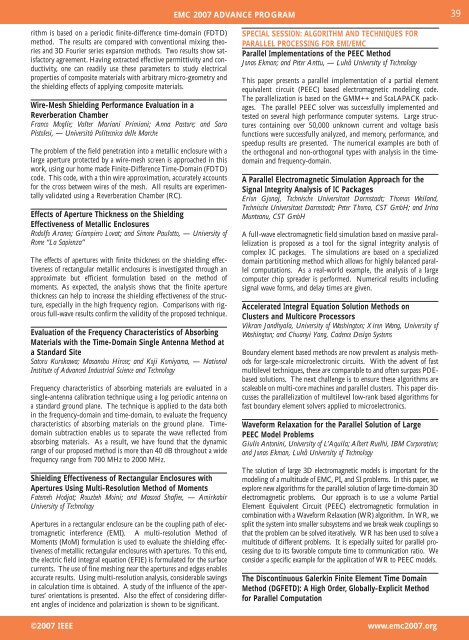2007 ieee international symposium on electromagnetic compatibility
2007 ieee international symposium on electromagnetic compatibility
2007 ieee international symposium on electromagnetic compatibility
You also want an ePaper? Increase the reach of your titles
YUMPU automatically turns print PDFs into web optimized ePapers that Google loves.
EMC <str<strong>on</strong>g>2007</str<strong>on</strong>g> ADVANCE PROGRAM 39rithm is based <strong>on</strong> a periodic finite-difference time-domain (FDTD)method. The results are compared with c<strong>on</strong>venti<strong>on</strong>al mixing theoriesand 3D Fourier series expansi<strong>on</strong> methods. Two results show satisfactoryagreement. Having extracted effective permittivity and c<strong>on</strong>ductivity,<strong>on</strong>e can readily use these parameters to study electricalproperties of composite materials with arbitrary micro-geometry andthe shielding effects of applying composite materials.Wire-Mesh Shielding Performance Evaluati<strong>on</strong> in aReverberati<strong>on</strong> ChamberFranco Moglie; Valter Mariani Primiani; Anna Pastore; and SaraPistolesi, — Università Politecnica delle MarcheThe problem of the field penetrati<strong>on</strong> into a metallic enclosure with alarge aperture protected by a wire-mesh screen is approached in thiswork, using our home made Finite-Difference Time-Domain (FDTD)code. This code, with a thin wire approximati<strong>on</strong>, accurately accountsfor the cross between wires of the mesh. All results are experimentallyvalidated using a Reverberati<strong>on</strong> Chamber (RC).Effects of Aperture Thickness <strong>on</strong> the ShieldingEffectiveness of Metallic EnclosuresRodolfo Araneo; Giampiero Lovat; and Sim<strong>on</strong>e Paulotto, — University ofRome “La Sapienza”The effects of apertures with finite thickness <strong>on</strong> the shielding effectivenessof rectangular metallic enclosures is investigated through anapproximate but efficient formulati<strong>on</strong> based <strong>on</strong> the method ofmoments. As expected, the analysis shows that the finite aperturethickness can help to increase the shielding effectiveness of the structure,especially in the high frequency regi<strong>on</strong>. Comparis<strong>on</strong>s with rigorousfull-wave results c<strong>on</strong>firm the validity of the proposed technique.Evaluati<strong>on</strong> of the Frequency Characteristics of AbsorbingMaterials with the Time-Domain Single Antenna Method ata Standard SiteSatoru Kurokawa; Masanobu Hirose; and Koji Komiyama, — Nati<strong>on</strong>alInstitute of Advanced Industrial Science and TechnologyFrequency characteristics of absorbing materials are evaluated in asingle-antenna calibrati<strong>on</strong> technique using a log periodic antenna <strong>on</strong>a standard ground plane. The technique is applied to the data bothin the frequency-domain and time-domain, to evaluate the frequencycharacteristics of absorbing materials <strong>on</strong> the ground plane. Timedomainsubtracti<strong>on</strong> enables us to separate the wave reflected fromabsorbing materials. As a result, we have found that the dynamicrange of our proposed method is more than 40 dB throughout a widefrequency range from 700 MHz to 2000 MHz.Shielding Effectiveness of Rectangular Enclosures withApertures Using Multi-Resoluti<strong>on</strong> Method of MomentsFatemeh Hodjat; Rouzbeh Moini; and Masood Shafiee, — AmirkabirUniversity of TechnologyApertures in a rectangular enclosure can be the coupling path of <strong>electromagnetic</strong>interference (EMI). A multi-resoluti<strong>on</strong> Method ofMoments (MoM) formulati<strong>on</strong> is used to evaluate the shielding effectivenessof metallic rectangular enclosures with apertures. To this end,the electric field integral equati<strong>on</strong> (EFIE) is formulated for the surfacecurrents. The use of fine meshing near the apertures and edges enablesaccurate results. Using multi-resoluti<strong>on</strong> analysis, c<strong>on</strong>siderable savingsin calculati<strong>on</strong> time is obtained. A study of the influence of the apertures’orientati<strong>on</strong>s is presented. Also the effect of c<strong>on</strong>sidering differentangles of incidence and polarizati<strong>on</strong> is shown to be significant.SPECIAL SESSION: ALGORITHM AND TECHNIQUES FORPARALLEL PROCESSING FOR EMI/EMCParallel Implementati<strong>on</strong>s of the PEEC MethodJ<strong>on</strong>as Ekman; and Peter Anttu, — Luleå University of TechnologyThis paper presents a parallel implementati<strong>on</strong> of a partial elementequivalent circuit (PEEC) based <strong>electromagnetic</strong> modeling code.The parallelizati<strong>on</strong> is based <strong>on</strong> the GMM++ and ScaLAPACK packages.The parallel PEEC solver was successfully implemented andtested <strong>on</strong> several high performance computer systems. Large structuresc<strong>on</strong>taining over 50,000 unknown current and voltage basisfuncti<strong>on</strong>s were successfully analyzed, and memory, performance, andspeedup results are presented. The numerical examples are both ofthe orthog<strong>on</strong>al and n<strong>on</strong>-orthog<strong>on</strong>al types with analysis in the timedomainand frequency-domain.A Parallel Electromagnetic Simulati<strong>on</strong> Approach for theSignal Integrity Analysis of IC PackagesEri<strong>on</strong> Gj<strong>on</strong>aj, Technische Universitaet Darmstadt; Thomas Weiland,Technische Universitaet Darmstadt; Peter Thoma, CST GmbH; and IrinaMunteanu, CST GmbHA full-wave <strong>electromagnetic</strong> field simulati<strong>on</strong> based <strong>on</strong> massive parallelizati<strong>on</strong>is proposed as a tool for the signal integrity analysis ofcomplex IC packages. The simulati<strong>on</strong>s are based <strong>on</strong> a specializeddomain partiti<strong>on</strong>ing method which allows for highly balanced parallelcomputati<strong>on</strong>s. As a real-world example, the analysis of a largecomputer chip spreader is performed. Numerical results includingsignal wave forms, and delay times are given.Accelerated Integral Equati<strong>on</strong> Soluti<strong>on</strong> Methods <strong>on</strong>Clusters and Multicore ProcessorsVikram Jandhyala, University of Washingt<strong>on</strong>; Xiren Wang, University ofWashingt<strong>on</strong>; and Chuanyi Yang, Cadence Design SystemsBoundary element based methods are now prevalent as analysis methodsfor large-scale microelectr<strong>on</strong>ic circuits. With the advent of fastmultilevel techniques, these are comparable to and often surpass PDEbasedsoluti<strong>on</strong>s. The next challenge is to ensure these algorithms arescaleable <strong>on</strong> multi-core machines and parallel clusters. This paper discussesthe parallelizati<strong>on</strong> of multilevel low-rank based algorithms forfast boundary element solvers applied to microelectr<strong>on</strong>ics.Waveform Relaxati<strong>on</strong> for the Parallel Soluti<strong>on</strong> of LargePEEC Model ProblemsGiulio Ant<strong>on</strong>ini, University of L’Aquila; Albert Ruelhi, IBM Corporati<strong>on</strong>;and J<strong>on</strong>as Ekman, Luleå University of TechnologyThe soluti<strong>on</strong> of large 3D <strong>electromagnetic</strong> models is important for themodeling of a multitude of EMC, PI, and SI problems. In this paper, weexplore new algorithms for the parallel soluti<strong>on</strong> of large time-domain 3D<strong>electromagnetic</strong> problems. Our approach is to use a volume PartialElement Equivalent Circuit (PEEC) <strong>electromagnetic</strong> formulati<strong>on</strong> incombinati<strong>on</strong> with a Waveform Relaxati<strong>on</strong> (WR) algorithm. In WR, wesplit the system into smaller subsystems and we break weak couplings sothat the problem can be solved iteratively. WR has been used to solve amultitude of different problems. It is especially suited for parallel processingdue to its favorable compute time to communicati<strong>on</strong> ratio. Wec<strong>on</strong>sider a specific example for the applicati<strong>on</strong> of WR to PEEC models.The Disc<strong>on</strong>tinuous Galerkin Finite Element Time DomainMethod (DGFETD): A High Order, Globally-Explicit Methodfor Parallel Computati<strong>on</strong>©<str<strong>on</strong>g>2007</str<strong>on</strong>g> IEEE www.emc<str<strong>on</strong>g>2007</str<strong>on</strong>g>.org
















